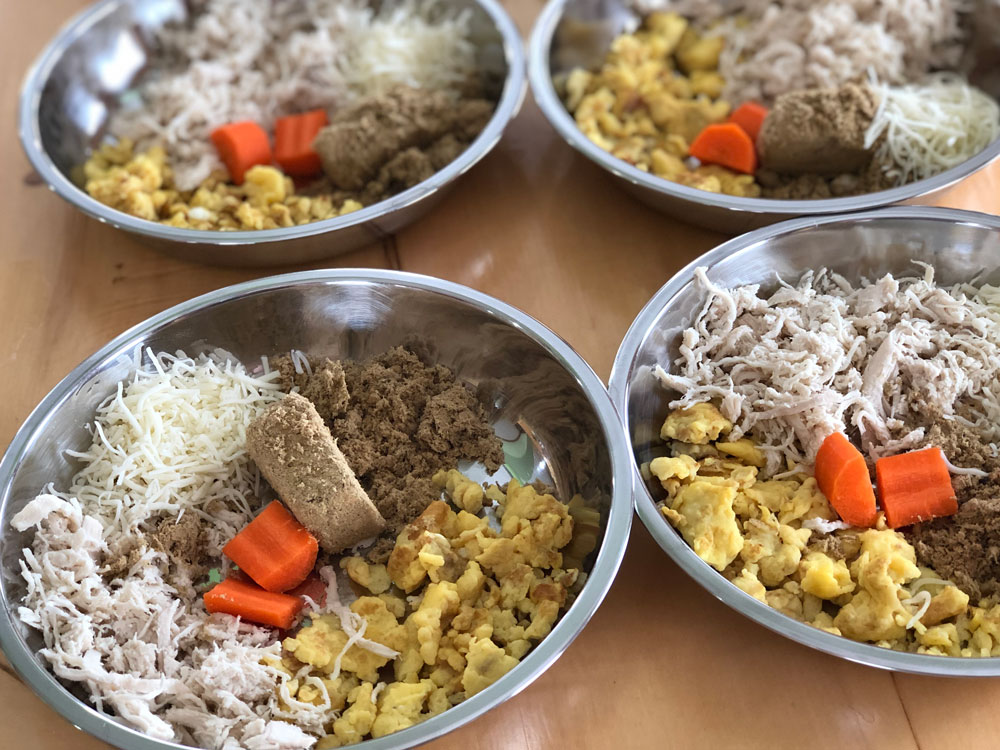We always had dogs when I was a kid. They didn’t get kibbles to eat but we had canned dog food in the pantry and my mother would give them leftovers from what she cooked for us. However, some foods like desert, chicken bones, spicy things, etc. were not allowed for the dogs. Our dogs were healthy, they lived to be 15+ years.
Nowadays I hear about dogs with cancer all the time, dogs with liver and kidney disease, auto-immune diseases, allergies, and skin problems.
Veterinarians, online articles and social media are warning us, that if we feed our dogs human food, we will be making them sick. We didn’t eat the junk food that people eat nowadays and I agree that it is not recommended to include our dogs in our junk food habits but in my opinion, there is no harm in sharing a well-balanced diet with my dog.
Do you think commercial dog food is good for your dog?
Here is something you just have to read and visualize to understand what ingredients those so-called “Animal by-product meal, Meat by-product meal or Animal fat” really are.
It is shocking but true, taken from an article published by the Earth Island Journal.
“The rendering plant floor is piled high with ‘raw product’. Thousands of dead dogs and cats; heads and hooves from cattle, sheep, pigs and horses; whole skunks; rats and raccoons — all waiting to be processed.
“In the ninety degree heat, the piles of dead animals seem to have a life of their own as millions of maggots swarm over the carcasses.
“Two bandanna-masked men begin operating Bobcat mini-dozers, loading the ‘raw’ into a ten-foot deep stainless steel pit. They are undocumented workers from Mexico doing a dirty job.
“A giant auger at the bottom of the pit begins to turn. Popping bones and squeezing flesh are sounds from a nightmare you will never forget.
“Rendering is the process of cooking raw animal material to remove the moisture and fat. The rendering plant works like a giant kitchen.
“The cooker, or ‘chef’, blends the raw product in order to maintain a certain ratio between the carcasses of pets, livestock, poultry waste and supermarket rejects.
“Once the mass is cut into small pieces, it is transported to another auger for fine shredding. It is then cooked at 280 degrees for one hour.
“The continuous batch cooking process goes on non-stop, 24 hours a day, seven days a week as meat is melted away from bones in the hot “soup”.
“During this cooking process, the “soup” produces a fat of yellow grease or tallow that rises to the top and is skimmed off.
“The cooked meat and bone are sent to a hammer-mill press, which squeezes out the remaining moisture and pulverizes the product into a gritty powder.
“Shaker screens sift out excess hair and large bone chips. Once the batch is finished, all that is left is yellow grease, meat and bone meal.”
Many rendering plants are processing toxic waste, too. Dead animals come with lots of unwanted contaminants. Pesticides go into the rendering process via livestock. Fish oil is contaminated with mercury and other heavy metals. Dead pets collected from shelters are added into the grinder with their flea collars still attached. Insecticide-laced patches found on the skin of slaughtered cattle are also added to the mix. Antibiotics and other pharmaceuticals follow livestock directly into the soup. And drugs given to euthanize animals have been regularly found in the rendered product.
There are lots of videos online showing what pet owners found in dog food bags. Unwanted metal contaminants can be traced to a variety of sources including pet collars, ID tags, surgical pins, and needles. Even plastics can sometimes end up in the process.
Every day, out-of-date supermarket meats as well as spoiled fish and poultry arrive by the truckload, right in their original Styrofoam trays and shrink wrap. There’s simply no time to unwrap each package of the thousands of rejected products. Plastic cattle ID lags, pesticide patches, and even the green waste disposal bags containing dead pets from veterinary clinics and shelters are tossed directly into the pit.
As difficult as it can be to imagine, literally all of it — plastic, paper, cardboard — goes right into the rendering machine.
Every day, hundreds of rendering plants across America ship thousands of pounds of this recycled rubbish to ranches, farms, feedlots — and pet food manufacturers.
Here’s a short list of some of the unsavory raw materials already mentioned — plus a few others. And although each of the following ingredients is appalling, each is lawfully used to make dog food:
- Slaughterhouse waste (organs, heads, hooves, beaks, feet)
- Bread and cereal rejects (cobs, stalks, mill sweepings)
- Dying, diseased and disabled farm animals
- Roadkill (deer, skunks, and raccoons)
- Contaminated grain middlings
- Distiller fermentation waste
- Spoiled supermarket food
- Euthanized cats and dogs
- Restaurant grease
- Dead zoo animals
We hope that after reading this it’s become obvious to you that the pet food industry can be nothing more than a sinister waste disposal vehicle for human food manufacturers — and a way to profit from its own garbage. That’s why it’s so important for every dog owner to be able to spot these dubious ingredients — and to avoid buying the products that have been made using these questionable materials.
Please do your research. Watch the documentary PetFooled on Netflix or Amazon Prime.
Here at Rocky Mountain Biewer Terriers, we feed Life’s Abundance as a supplemental kibble. We cook for our dogs and serve them balanced meals twice a day. Here are some meal ideas for Biewer Terriers.














I’d love a list of what exactly is in your home cooked meals.
Thanks so much,
Debra Pierson